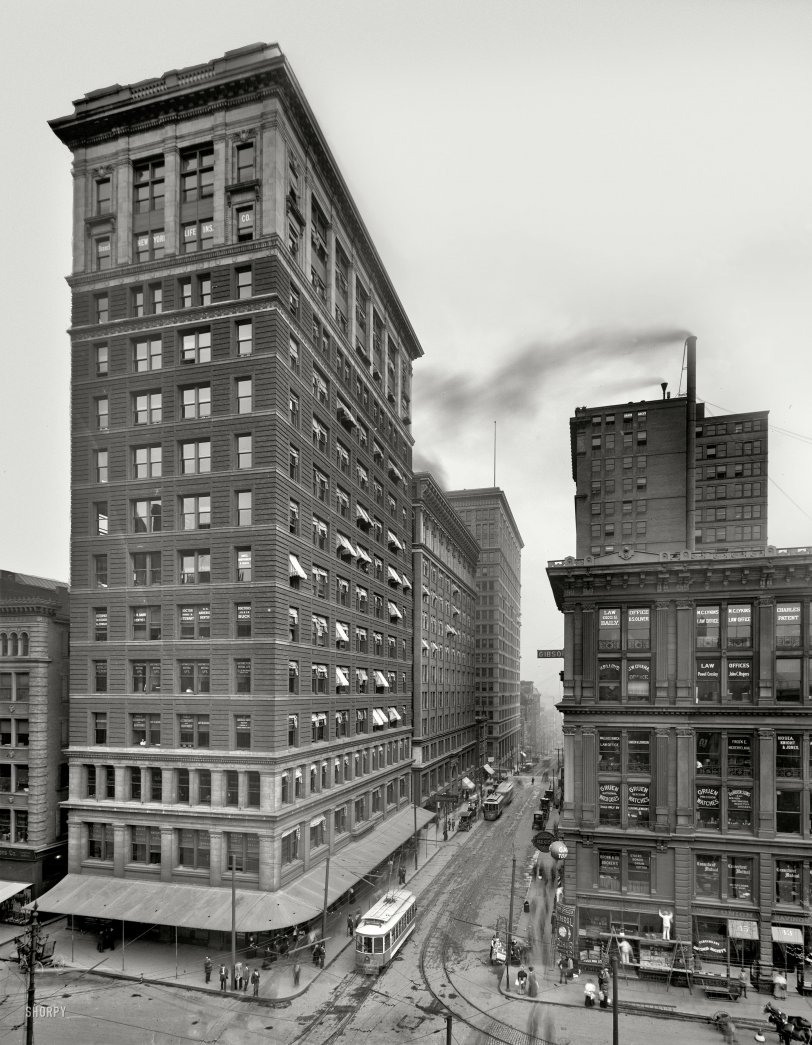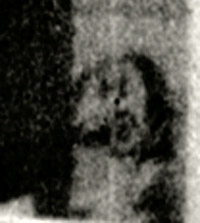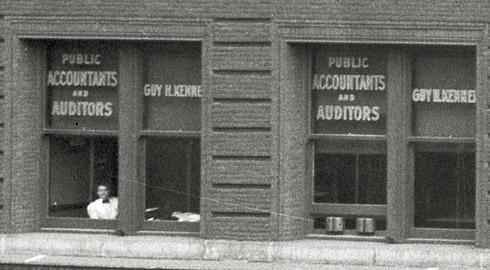


Framed or unframed, desk size to sofa size, printed by us in Arizona and Alabama since 2007. Explore now.
Shorpy is funded by you. Patreon contributors get an ad-free experience.
Learn more.

- Baldwin 62303
- Baldwin VO-1000
- Cold
- No expense spared
- Tough Guys
- Lost in Toyland
- And without gloves
- If I were a blindfolded time traveler
- Smoke Consumer Also Cooks
- Oh that stove!
- Possibly still there?
- What?!?
- $100 Reward
- Freeze Frame
- Texas Flyer wanted
- Just a Year Too Soon
- WWII -- Replacing men with women at the railroad crossing.
- Yes, Icing
- You kids drive me nuts!
- NOT An Easy Job
- I wonder
- Just add window boxes
- Icing Platform?
- Indiana Harbor Belt abides
- Freezing haze
- Corrections (for those who care)
- C&NW at Nelson
- Fallen Flags
- A dangerous job made worse
- Water Stop
Print Emporium
Walnut Street: 1910

Cincinnati, Ohio, circa 1910. "Walnut Street." A detailed street scene in the business district. Detroit Publishing Co. glass negative. View full size.
Let's Get These Buildings Straight ...
After much surfing, I have obtained the following results: The tall 15-story building on the left is the Traction Building (now the Tri-State Building) of D.H. Burnham & Co. (1902); the shorter building next to it on the right (looks like 11 stories, but it's actually 13) is the Young Men's Mercantile Library Building (Joseph Steinkamp & Brother, 1902-1903); and the third tall building on the left is the First National Bank, again of D.H. Burnham & Co. (1903). The Union Savings & Trust Co. (now Bartlett) Building (D.H. Burnham & Co., 1901-1902) is on the right in the background. It seems that all four are still standing. I'm not from Cincinnati, so I hope I got this right.
Mercantile Library
If I'm not mistaken, I believe that those top floors are the Mercantile Library. They've just celebrated 175 years.
I worked here
This is the Bartlett building. I worked there 1989-1991. American Airlines had a reservations office on the top four floors (they moved out about five years ago) and a ticket office at street level. My office was on the 11th floor and my window was in the center of the eastern side.
I loved that building. Sometimes we'd go up to the roof at lunch and have a great view of the river. The top floor was storage and had all sorts of stuff stashed away. I never took the time to explore that area too much.
GAME TODAY globe
This sign must refer to the Reds/Redlegs having a home game the day this picture was taken. Maybe the cigar store below it was a place to buy tickets. Had the Crosleys an interest in the team as early as 1910?
And who else besides me remembers those little Crosley cars and that innovative Crosley "Shelvador" refrigerator? Until then, no-one thought to put shelving on the inside of a refrigerator door.
Slightly creepy apparition
I have no idea what might be causing the illusion, but there's a really angry looking cartoon-like face in the window at the lower left-hand corner of the taller building. It sort of resembles a Peanuts character screaming "AAAUUUGH!"

Fort Thomas streetcar
The streetcar has a destination of Fort Thomas which was across the Ohio River in Kentucky.
I remember Fort Thomas quite well as it was the home of the military induction center for the area. In those days if you were 18 or over, you were required to serve in the military. You either joined or eventually got drafted.
I took my physical for the Air Force at Fort Thomas in August, 1961. That was an experience I will never forget. For those of you who have been through it, I'm sure you will agree.
Those high-up window signs
When I see those 10th-story windows advertising various trades, I always wonder what use they were. Maybe a couple dozen people working in the building across the street would be able to read them, but they certainly seem like they would be invisible or too far away to the multitudes at street level.
Drach Architect
Drach Architect (top floor) designed the Cincinnati Water Works building shown in this Shorpy post.
Porkopolis?
I don't see any hogs in the streets. Must be after they lost the butchering title to Chicago.
East Fifth & Walnut
This is a view from the corner of East Fifth and Walnut looking south down Walnut. Fourth is the next intersection on Walnut, where the street can be seen beginning to slope down toward the Ohio River.
Most of the buildings on the left still exist.
Powel Crosley Sr.
Today's famous-name-in-gold-on-a-window is Powel Crosley, who was then a 60-year-old attorney and real estate developer with two precocious sons (Lewis and Powel Jr.). In 1910 Powel Sr. asked college dropout Powel Jr. (not for the last time) when he was going to start making something of himself. Powel Jr. loved cars but couldn't get traction in the business, until he invented a new type of tire and borrowed $500 from dad to try to market it. With the help of Lewis, Powel Jr. used that product as the foundation for what would become one of the nation's largest auto parts companies. A business empire that included radios, refrigerators, proximity fuzes, radio stations, ownership of the Reds, and many other successes followed.
Medical Arts
Do I win the prize? I spotted two doctors' offices, two dentists' offices, and a rare osteopath. (You just don't see those very often).
Sidewalk Bustle
Most of the bustle looks to be on the sidewalks. The streets are relatively quiet. Even the street vendor is standing in the street so as not to block the pedestrian traffic on the sidewalk.
I imagine today it would be the opposite.
Powel Crosley Law Offices
This is the office of Powel Crosley Sr. He was the father of Powel Crosley Jr. and Lewis Crosley. Powel Jr. later bought the Cincinnati Reds baseball team and the ball field that they used until 1970 was called Crosley Field.
Powel Jr. was interested in automobiles and was tinkering with cars and selling auto accessories shortly after this photo was made.
Powel Jr. was born in 1886 and was 24 years old at the time of this photo.
Interesting reading about the Crosley family can be found in the book "Crosley" by Rusty McClure. Some interesting old photos can be found there too.
Early retouching
What happened to the sky on the left side of the photo?
[It was inked out. - Dave]

Oh, that Crosley
Powel Crosley (law office, fourth floor, lower right in photo) was the father of Powel Crosley, Jr., a Cincinnati icon for years. Jr. not only invented, patented and built automobiles and low-priced radios (among other consumer products) in the first half of the 20th century, he was also a giant in early radio and television broadcasting. As kids growing up in southwest Ohio, our standard joke was that one could hear "blowtorch" WLW radio (700AM, still o the air) by wrapping one's mouth around a metal fence strand and receive a signal through our (metal) fillings.
Crosley's biggest claim to fame may have been his ownership of the Cincinnati Reds, beginning in 1934. He rechristened Crosley Field in his own honor, and was the first to hold night baseball games (in 1935). A rite of passage for kids in my era ('50s-'60s) was to attend opening day at bandbox-sized Crosley field, skipping school of course.
Business, Indeed
Loads of lawyers in the building to the right, and insurance and accounts to the left. Love the auditor looking out the window -- to keep an eye on the lawyers??

What's missing?
Someone removed a bunch of something from the top and left of the big building.
Evidence?
[Part of the sky was masked out on the negative. - Dave]
Scary scaffolding
Those guys at the bottom right obviously must know what they're doing.
It's an Alternate Life
The lawyer occupying an office on the top floor of the building on the far right is George Baily. I guess Frank Capra had an alternate ending or storyline, one where George is forced to leave Pottersville, goes to Law School and winds up in Cincinnati.
























On Shorpy:
Today’s Top 5